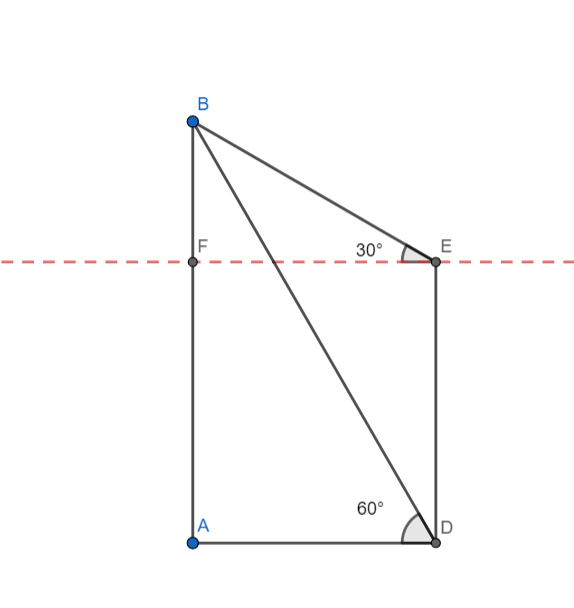
The top of a 15m high tower makes an angle of elevation of $60{}^\circ $ with the bottom of an electric pole and an angle of elevation of $30{}^\circ $ with the top of the pole. What is the height of the electric pole?
[a] 5m
[b] 8m
[c] 10m
[d] 12m
Answer
593.1k+ views
Hint: Use the fact that $\tan \theta =\dfrac{\text{Opposite side}}{\text{Adjacent side}}$. Find tan of angle D in triangle BDA and use the fact that $\tan 60{}^\circ =\sqrt{3}$. Hence find the length of the side AD. Again find tan if angle E in triangle BEF and use the fact that $\tan 30{}^\circ =\sqrt{3}$ and hence find the length of the side BF. Use the fact that ED = AB – BF to determine the height of the tower.
Complete step-by-step answer:

AB is a tower of height 15m. ED is an electric pole at a distance from the tower, The angle of elevation from the top(E) of the pole to the top(B) of the tower is $30{}^\circ $ , and the angle of elevation of the bottom(D) of the pole to the top(B) of the tower is $60{}^\circ $.
To find: The height of the pole ED.
In triangle ABD, we have AB is the side opposite to D and AD is the side adjacent to D.
We know that $\tan \theta =\dfrac{\text{Opposite side}}{\text{Adjacent side}}$
Hence, we have
$\tan D=\dfrac{AB}{AD}$
We know that $AB=15,D=60{}^\circ $
Hence, we have
$\tan 60{}^\circ =\dfrac{15}{AD}$
We know that $\tan 60{}^\circ =\sqrt{3}$
Hence, we have $\sqrt{3}=\dfrac{15}{AD}$
Multiplying both sides by AD, we get
$\sqrt{3}AD=15$
Dividing both sides by $\sqrt{3},$ we get
$AD=\dfrac{15}{\sqrt{3}}=5\sqrt{3}$
Since ADEF is a rectangle, we have AD = EF.
Hence, we have $EF=5\sqrt{3}$
Now, in triangle BEF, we have
BF is the side opposite to E, and FE is the side adjacent to E.
We know that $\tan \theta =\dfrac{\text{Opposite side}}{\text{Adjacent side}}$
Hence, we have
$\tan E=\dfrac{BF}{FE}$
We know that $EF=5\sqrt{3}$ and $E=30{}^\circ $
Hence, we have
$\tan 30{}^\circ =\dfrac{BF}{5\sqrt{3}}$
We know that $\tan 30{}^\circ =\dfrac{1}{\sqrt{3}}$
Hence, we have
$\dfrac{1}{\sqrt{3}}=\dfrac{BF}{5\sqrt{3}}$
Multiplying both sides by $5\sqrt{3}$, we get
$BF=5$
Now, we know that
BF+FA = AB
Since ADEF is a rectangle, we have AF = ED
Hence, we have
BF+ED = AB
ED + 5 = 15
Subtracting 5 from both sides, we get
ED = 10
Hence the height of the pole is 10m.
Hence option [c] is correct.
Note: Verification:
In triangle BEF, we have
$\tan E=\dfrac{BF}{EF}=\dfrac{5}{5\sqrt{3}}=\dfrac{1}{\sqrt{3}}$
Hence, we have
$\tan E=\tan 30{}^\circ \Rightarrow E=30{}^\circ $
Hence the angle of elevation of the top of the tower from the top of the pole is $30{}^\circ $
In triangle ABD, we have
$\tan D=\dfrac{AB}{AD}=\dfrac{15}{5\sqrt{3}}=\sqrt{3}\Rightarrow D=60{}^\circ $
Hence the angle of elevation of the top of the tower from the bottom of the pole is $60{}^\circ $
Hence our answer is verified to be correct.
Complete step-by-step answer:

AB is a tower of height 15m. ED is an electric pole at a distance from the tower, The angle of elevation from the top(E) of the pole to the top(B) of the tower is $30{}^\circ $ , and the angle of elevation of the bottom(D) of the pole to the top(B) of the tower is $60{}^\circ $.
To find: The height of the pole ED.
In triangle ABD, we have AB is the side opposite to D and AD is the side adjacent to D.
We know that $\tan \theta =\dfrac{\text{Opposite side}}{\text{Adjacent side}}$
Hence, we have
$\tan D=\dfrac{AB}{AD}$
We know that $AB=15,D=60{}^\circ $
Hence, we have
$\tan 60{}^\circ =\dfrac{15}{AD}$
We know that $\tan 60{}^\circ =\sqrt{3}$
Hence, we have $\sqrt{3}=\dfrac{15}{AD}$
Multiplying both sides by AD, we get
$\sqrt{3}AD=15$
Dividing both sides by $\sqrt{3},$ we get
$AD=\dfrac{15}{\sqrt{3}}=5\sqrt{3}$
Since ADEF is a rectangle, we have AD = EF.
Hence, we have $EF=5\sqrt{3}$
Now, in triangle BEF, we have
BF is the side opposite to E, and FE is the side adjacent to E.
We know that $\tan \theta =\dfrac{\text{Opposite side}}{\text{Adjacent side}}$
Hence, we have
$\tan E=\dfrac{BF}{FE}$
We know that $EF=5\sqrt{3}$ and $E=30{}^\circ $
Hence, we have
$\tan 30{}^\circ =\dfrac{BF}{5\sqrt{3}}$
We know that $\tan 30{}^\circ =\dfrac{1}{\sqrt{3}}$
Hence, we have
$\dfrac{1}{\sqrt{3}}=\dfrac{BF}{5\sqrt{3}}$
Multiplying both sides by $5\sqrt{3}$, we get
$BF=5$
Now, we know that
BF+FA = AB
Since ADEF is a rectangle, we have AF = ED
Hence, we have
BF+ED = AB
ED + 5 = 15
Subtracting 5 from both sides, we get
ED = 10
Hence the height of the pole is 10m.
Hence option [c] is correct.
Note: Verification:
In triangle BEF, we have
$\tan E=\dfrac{BF}{EF}=\dfrac{5}{5\sqrt{3}}=\dfrac{1}{\sqrt{3}}$
Hence, we have
$\tan E=\tan 30{}^\circ \Rightarrow E=30{}^\circ $
Hence the angle of elevation of the top of the tower from the top of the pole is $30{}^\circ $
In triangle ABD, we have
$\tan D=\dfrac{AB}{AD}=\dfrac{15}{5\sqrt{3}}=\sqrt{3}\Rightarrow D=60{}^\circ $
Hence the angle of elevation of the top of the tower from the bottom of the pole is $60{}^\circ $
Hence our answer is verified to be correct.
Recently Updated Pages
Master Class 11 Economics: Engaging Questions & Answers for Success

Master Class 11 English: Engaging Questions & Answers for Success

Master Class 11 Social Science: Engaging Questions & Answers for Success

Master Class 11 Biology: Engaging Questions & Answers for Success

Class 11 Question and Answer - Your Ultimate Solutions Guide

Master Class 11 Business Studies: Engaging Questions & Answers for Success

Trending doubts
What is meant by exothermic and endothermic reactions class 11 chemistry CBSE

10 examples of friction in our daily life

One Metric ton is equal to kg A 10000 B 1000 C 100 class 11 physics CBSE

Difference Between Prokaryotic Cells and Eukaryotic Cells

What are Quantum numbers Explain the quantum number class 11 chemistry CBSE

1 Quintal is equal to a 110 kg b 10 kg c 100kg d 1000 class 11 physics CBSE




